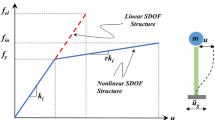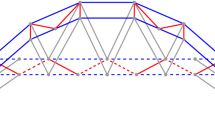Abstract
Ground anchorage systems are used extensively throughout the world as supporting devices for civil engineering structures such as bridges and tunnels. The condition monitoring of ground anchorages is a new area of research, with the long term objective being a wholly automated or semi-automated condition monitoring system capable of repeatable and accurate diagnosis of faults and anchorage post-tension levels. The ground anchorage integrity testing (GRANIT) system operates by applying an impulse of known force by means of an impact device that is attached to the tendon of the anchorage. The vibration signals that arise from this impulse are complex in nature and require analysis to be undertaken in order to extract information from the vibrational response signatures that is relevant to the condition of the anchorage. Novel artificial intelligence techniques are used in order to learn the complicated relationship that exists between an anchorage and its response to an impulse. The system has a worldwide patent and is currently licensed commercially.
A lumped parameter dynamic model has been developed which is capable of describing the general frequency relationship with increasing post-tension level as exhibited by the signals captured from real anchorages. The normal procedure with the system is to train a neural network on data that has been taken from an anchorage over a range of post-tension levels. Further data is needed in order to test the neural network. This process can be time consuming, and the lumped parameter dynamic model has the potential of producing data that could be used for training purposes, thereby reducing the amount of time needed on site, and reducing the overall cost of the system's operation.
This paper presents data that has been produced by the lumped parameter dynamic model and compares it with data from a real anchorage. Noise is added to the results produced by the lumped parameter dynamic model in order to match more closely the experimental data. A neural network is trained on the data produced by the model, and the results of diagnosis of real data are presented. Problems are encountered with the diagnosis of the neural network with experimental data, and a new method for the training of the neural network is explored. The improved results of the neural network trained on data produced by the lumped parameter dynamic model to experimental data are shown. It is shown how the results from the lumped parameter dynamic model correspond well to the experimental results.
Similar content being viewed by others
References
The Institution of Civil Engineers, A National Agenda for Long-term and Fundamental Research for Civil Engineering in the United Kingdom, Thomas Telford Ltd, London, 1992.
British Standards Institution, British Standard Code of Practice for Ground Anchorages (8081), 1989.
Ifeachor, J., Digital Signal Processing: A Practical Approach, Addison-Wesley, Reading, MA, 1993.
Kraniauskas, P., Transforms in Signals and Systems, Addison-Wesley, Reading, MA, 1992.
Ludeman, L.C., Fundamentals of Digital Signal Processing, Wiley, New York, 1986.
Misiti, M., Misiti, Y., Oppenheim, G., Poggi, J.-M., Wavelet Toolbox User's Guide, The Math Works, Inc., 1996.
Qian, S., Dapang, C., Joint Time-Frequency Analysis: Methods and Applications, Prentice-Hall, Inc., 1996.
Starkey, A., Penman, J., Rodger, A.A., ‘Condition monitoring of ground anchorage systems using an artificial neural network’, in: Proceedings of COMADEM'98, Vol. 2, 1998, pp. 793-802.
Starkey, A., Penman, J., Rodger, A.A., ‘Condition monitoring of ground anchorages using an artificial neural network and wavelet techniques’, in: Applications and Innovations in Intelligent Systems VII (ES99), 1999, pp. 283-290.
Swingler, K., Applying Neural Networks, Academic Press, New York, 1996.
Demuth, H., Beale, M., Neural Network Toolbox User's Guide, The Math Works Inc., 1994.
Haykin, S., Neural Networks: A Comprehensive Foundation, MacMillan College Publishing Company, Inc., 1994.
Signal Processing Toolbox, The Mathworks, Inc., 2000.
Ivanovic, A., Neilson, R.D. and Rodger, A.A., ‘Numerical modelling of single tendon ground anchorage systems’, Geotech. Eng. 149(2) (2001) 103-113.
Ivanovic, A., Neilson, R.D. and Rodger, A.A., ‘Influence of prestress on the dynamic response of ground anchorages’, ASCE, J. Geotech. Geoenviron. Eng. 128(3) (2002) 237-249.
Starkey, A., Condition Monitoring of Geotechnical Processes Using Artificial Intelligence Techniques, PhD Thesis, University of Aberdeen, 2001.
Using MATLAB (Version 5), The Math Works, Inc., 1996.
Connolly, E., Finite Element Modelling and Parametric Study of Resin Bonded Rock Bolt Systems, MPhil Thesis, University of Aberdeen, 1998.
Author information
Authors and Affiliations
Rights and permissions
About this article
Cite this article
Starkey, A., Ivanovic, A., Neilson, R.D. et al. Using a Lumped Parameter Dynamic Model of a Rock Bolt to Produce Training Data for a Neural Network for Diagnosis of Real Data. Meccanica 38, 133–144 (2003). https://doi.org/10.1023/A:1022031720855
Issue Date:
DOI: https://doi.org/10.1023/A:1022031720855




